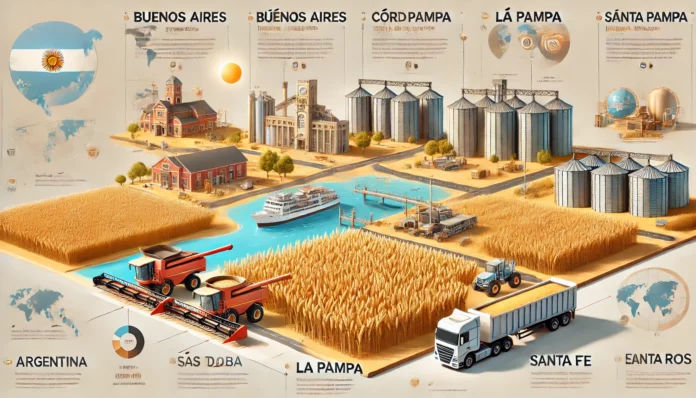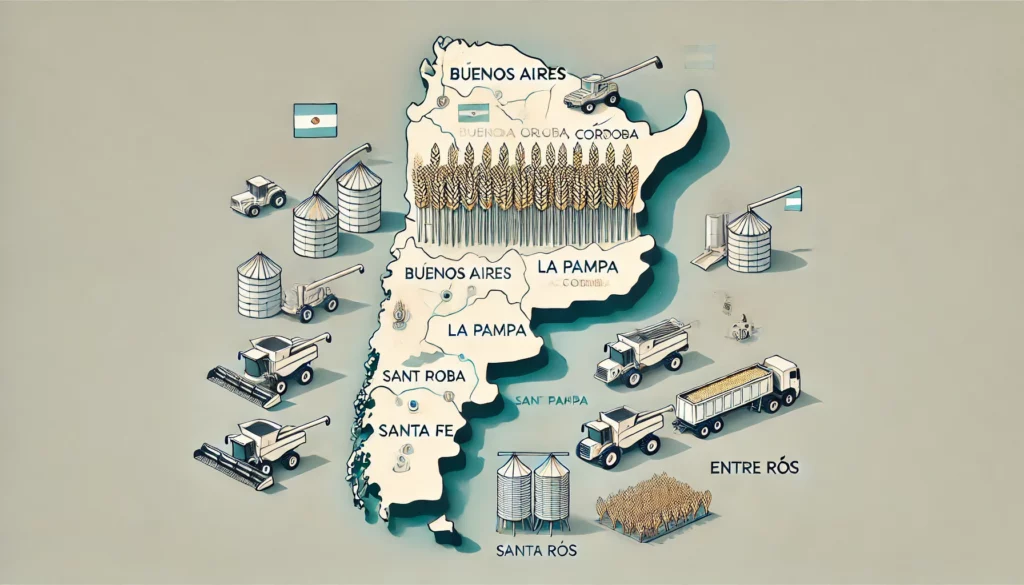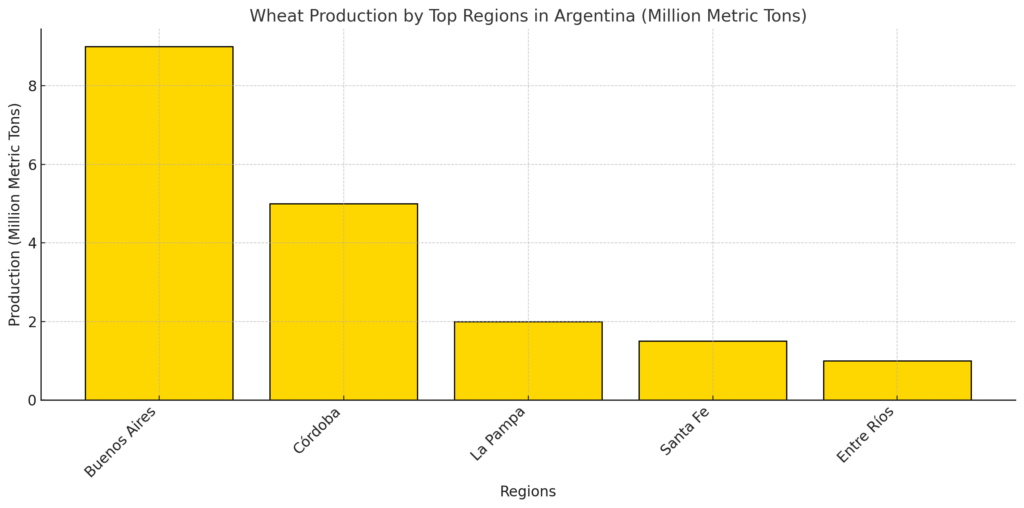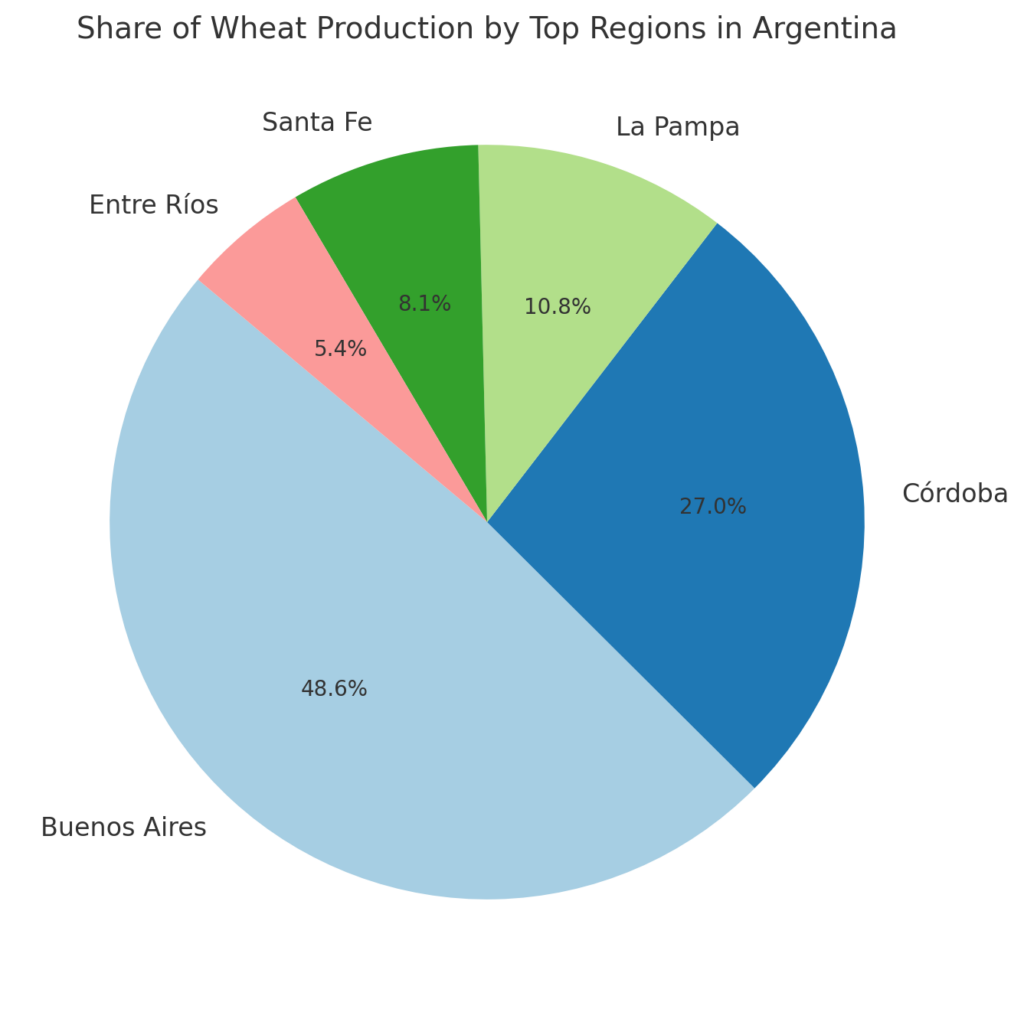
Argentina is one of the top wheat producers in the world, and its agricultural success is driven by its expansive plains and favorable climate conditions. Wheat is a staple crop in the country, and several regions play a crucial role in its production. This article takes a closer look at the largest wheat-producing regions in Argentina, their key characteristics, and their importance to both the local and global wheat markets.

1. Buenos Aires: The Heart of Argentina’s Wheat Industry
Buenos Aires is the leading wheat-producing province in Argentina, contributing to a large percentage of the country’s total wheat output.
- Annual Production: Approximately 9 million metric tons.
- Key Areas: The central and southeastern parts of the province.
- Major Crops: Winter wheat, with some spring wheat production.
- Innovations: Adoption of precision farming and no-till farming methods.
- Significance: Buenos Aires is the backbone of Argentina’s wheat industry, supplying both the domestic market and key export destinations like Brazil and Europe.
2. Córdoba: A Major Wheat Producer in Argentina
Córdoba is another major wheat-producing region, benefiting from its fertile soils and advanced farming practices.
- Annual Production: Around 5 million metric tons.
- Key Areas: The central and northern parts of the province.
- Major Crops: Wheat and other grains, including corn and soybeans, as part of a crop rotation system.
- Innovations: Use of crop rotation to maintain soil health and boost yields.
- Significance: Córdoba plays a vital role in Argentina’s agricultural economy, contributing a significant portion of the country’s wheat exports.
3. La Pampa: Growing Wheat Production in the South
La Pampa is an emerging wheat-producing region in Argentina, known for its vast plains and favorable weather conditions.
- Annual Production: Approximately 2 million metric tons.
- Key Areas: The central and western parts of the province.
- Major Crops: Winter wheat and a focus on high-quality wheat for milling.
- Innovations: Sustainable farming practices and the use of improved wheat seed varieties.
- Significance: La Pampa is steadily increasing its wheat output and is becoming an important contributor to Argentina’s wheat exports.
4. Santa Fe: A Key Player in Argentina’s Wheat Sector
Santa Fe is another province that contributes significantly to Argentina’s wheat production, thanks to its fertile soils and advanced farming techniques.
- Annual Production: Approximately 1.5 million metric tons.
- Key Areas: The central and northern regions of Santa Fe.
- Major Crops: Wheat and oilseeds, with a focus on high-quality wheat.
- Innovations: Emphasis on crop management techniques and efficient water usage.
- Significance: Santa Fe is an essential region for Argentina’s wheat supply chain, both for domestic consumption and export markets.
5. Entre Ríos: Wheat Production Along the Paraná River
Entre Ríos, located along the Paraná River, is a lesser-known but important wheat-producing region in Argentina.
- Annual Production: Around 1 million metric tons.
- Key Areas: The northeastern region of the province.
- Major Crops: Wheat, corn, and soybeans.
- Innovations: Focus on sustainable farming practices and efficient water management.
- Significance: Entre Ríos plays a crucial role in local wheat production and supports the region’s milling industry.

Innovations in Wheat Production in Argentina
Argentina is constantly evolving its wheat production practices to increase efficiency and sustainability. Key innovations include:
- Precision Agriculture: The use of GPS-guided tractors and data analytics to optimize planting, irrigation, and harvesting.
- No-Till Farming: This technique conserves soil moisture and reduces erosion, resulting in improved yields.
- Improved Seed Varieties: Development of drought-resistant and high-yield wheat varieties to cope with Argentina’s variable climate.
- Sustainable Practices: Crop rotation and integrated pest management help maintain soil health and reduce pesticide use.
Challenges in Argentina’s Wheat Industry
Despite Argentina’s success in wheat production, the industry faces several challenges:
- Climate Variability: Changes in rainfall patterns and temperature fluctuations can affect yields.
- Market Volatility: Fluctuating global wheat prices can impact profits for local producers.
- Infrastructure Issues: Inadequate storage and transportation infrastructure in some regions may hinder the efficient distribution of wheat.

Conclusion
Argentina’s largest wheat-producing regions, such as Buenos Aires, Córdoba, and La Pampa, are integral to the country’s agricultural economy and global wheat supply chain. With ongoing innovations in farming techniques and sustainable practices, Argentina continues to be a top wheat exporter. However, addressing challenges like climate variability and infrastructure limitations will be essential for the country to maintain its position as a global wheat leader.



